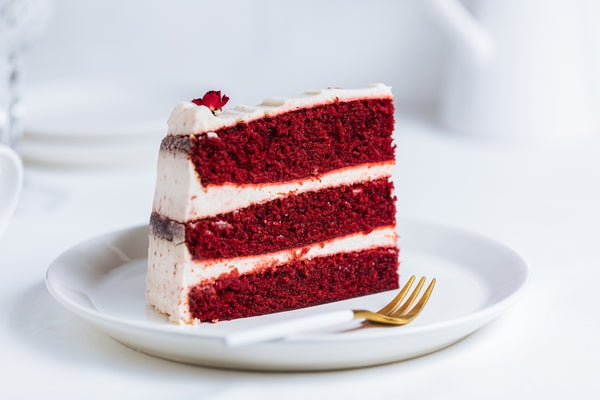Red velvet cake is a classic and beloved dessert with a striking crimson hue and fluffy texture. Originating from a tradition that blends both art and science, this cake marries the subtle flavors of cocoa and vanilla that evoke a sense of nostalgia and mystery.
Many have sat at dinner tables, fork in hand, pondering over the deep color and distinctive taste of this cake. Is it chocolate? If so, why is it red?
A symbol of celebration, red velvet cake often becomes the centerpiece of diverse occasions, from weddings to anniversaries and birthdays. This tantalizing cake has been a favorite for generations, gracing tables at special events and creating memories. But what is red velvet, and what gives it its distinct color and rich taste? The answer is in its chemistry.
Keep reading to learn more about red velvet cake, what it is, why it’s red, and why it’s one of the most popular desserts.
- What Is Red Velvet?
- Why Is Red Velvet Cake Red?
- What Does Red Velvet Taste Like?
- The Origins of Red Velvet
- Red Velvet vs. Chocolate Cake: Differences Explained
- Red Velvet: Final Thoughts
What Is Red Velvet?
Red velvet is a term used to describe a flavor that’s a mix of cocoa and vanilla, often available in baked cookies, cakes, and cupcakes. The most distinguishing feature of red velvet is its vibrant red or deep maroon color. While it has a mild cocoa flavor, it’s not as chocolatey as traditional chocolate cake, balancing both chocolate and vanilla flavors.
For many, a red velvet dessert is incomplete without its traditional accompaniment. A rich, moist red velvet cake paired with creamy, tangy cream cheese frosting complements the subtle cocoa undertones perfectly.
The origin of the red hue can be traced back to various sources, from the use of beet juice to keep the cake moist to modern food coloring.
Why Is Red Velvet Cake Red?
The distinctive red hue of red velvet has historical and modern explanations. Historically, the red color in the cake was a result of a chemical reaction. When acidic ingredients like buttermilk and vinegar were combined with natural pigments, also known as anthocyanins, in raw cocoa, it produced a natural reddish hue in the cake.
Though subtle, this organic reddish-brown tint signifies the delicious combination of ingredients, resonating with the cake’s unique taste. This color, combined with the cake’s luxurious texture, makes it a sought-after delicacy during festive occasions, setting it apart from regular chocolate and vanilla varieties.
In addition, some early recipes for red velvet cake used natural ingredients like beet juice to achieve the red color and increase the moistness of the cake. The use of beet juice, a natural dye, was an ingenious solution during times when artificial dyes weren’t available.
However, as the culinary world evolved and commercial food production took off, the bright red color began to be associated more with food coloring than its natural counterparts.
This transformation was accelerated during the Great Depression when the Adams Extract Company began promoting its food dyes by offering the red velvet cake recipe with its red food coloring to attract buyers, popularizing the vivid red version of the cake we all know and love.
In today’s red velvet cake, the iconic red hue primarily stems from this tradition of food coloring. The cake’s dramatic appearance and unparalleled flavor have ensured its position as a favorite for generations.
Gifting a red velvet cake or treat has become a popular tradition for many occasions. Its rich flavor and striking appearance make it a thoughtful choice for celebrations, including as a centerpiece or gift for a housewarming party, baby shower, or birthday celebration.
What Does Red Velvet Taste Like?
Red velvet has intrigued palates for generations, offering a taste that stands between vanilla and chocolate. While both of these flavors have their own fan bases, red velvet manages to draw admirers from both sides, providing a culinary experience that’s familiar yet new.
When you bite into a red velvet cake, cookie, or other sweet delicacy, there’s a prominent yet subtle cocoa flavor. But unlike the deep, rich notes of traditional chocolate cake that can sometimes be overpowering, red velvet ensures a more mellow cocoa taste.
This delicate hint of cocoa is enriched and balanced by the light tanginess of buttermilk and vinegar. These ingredients contribute to the cake’s distinctive flavor and soft, velvety texture.
The tangy undertones add depth to the flavor, making each bite delightfully sweet and sour. This combination ensures that red velvet stands out as a distinctive flavor.

The Origins of Red Velvet
The history of red velvet is just as fascinating as its unique flavor. Its earliest renditions were not as vibrant red as they are today. Instead, the red hue resulted from natural chemical reactions between the ingredients. When buttermilk and vinegar were mixed together, the anthocyanins in cocoa produced a reddish tint.
Historical accounts suggest that red velvet might have been named for its fine, velvety texture, a signature that made it different from other cakes.
At the same time, natural dyes may have made the hue stand out even more. Some bakers used beet juice to achieve a deeper red color and add moisture to the cake. In several regions, the cake was considered a luxury due to its intense labor and ingredient-rich profile. It wasn’t just a dessert but a reward served for special occasions.
Today, the vivid red color associated with red velvet cake is due to food coloring. During the Great Depression, the Adams Extract Company started promoting its food coloring by bundling it with the red velvet cake recipe. The marketing campaign popularized the super-red version of the cake, changing the perceptions and expectations about how red velvet cake should look.
Red Velvet vs. Chocolate Cake: Differences Explained
Since red velvet uses cocoa, you might wonder, “Is red velvet chocolate?” Some even argue that red velvet cake is chocolate cake, but that couldn’t be further from the truth, as both have distinct flavors. So what makes red velvet cake different? Let’s take a look at a few differences between red velvet and chocolate cake.
Flavor profile
What flavor is red velvet? While there are cocoa undertones, red velvet is not chocolate cake because it balances both chocolate and vanilla flavors. It contains cocoa but not the same quantity as traditional chocolate cake, resulting in a more subtle cocoa flavor and tanginess due to the buttermilk and vinegar. Its uniqueness is a harmonious blend that sets it apart from other cakes.
On the other hand, chocolate cake is chocolate-flavored, relying on cocoa and chocolate as the primary ingredients.
Texture
Beyond the flavor, one significant difference between red velvet and chocolate cake is the texture. Red velvet is renowned for its fine, velvety crumb, which sets it apart from denser chocolate cakes. The lightness in the texture of red velvet adds to its allure, making it a favorite choice for layered cakes or cupcakes.
Color
Red velvet cake is red because of natural reactions, dyes, or, most commonly, red food coloring. Conversely, chocolate cake is brown, reflecting the natural color of its primary ingredient, cocoa or chocolate.
Ingredients
Red velvet cake contains buttermilk and vinegar to add flavor and provide its classic reddish hue. On the other hand, while the ingredients in chocolate cake vary, buttermilk and vinegar are not standard in most recipes. This variation in ingredients impacts the color, flavor, and overall texture of the cakes.
Frosting
Red velvet cake is typically paired with cream cheese frosting to complement the mild cocoa and tangy flavors. Conversely, chocolate cake is often paired with rich chocolate or vanilla buttercream, ganache, or fudge frosting to emphasize the deep chocolate notes. The choice of frosting also plays a pivotal role in the taste, with the tangy cream cheese contrasting the subtle sweetness of red velvet.
Origins
Red velvet’s origins are somewhat mysterious, but it’s believed that it was popularized in the US during the 20th century. On the other hand, chocolate cake has ancient roots dating back to the Aztecs and Mayans. Modern chocolate cakes became popular in the 18th and 19th as cocoa became more widely available.
Red Velvet: Final Thoughts
Red velvet offers a unique flavor that balances cocoa and vanilla. Its deep red hue makes it stand out from the other cakes, making it a top choice for memorable occasions. From its fascinating origins to its iconic pairing with cream cheese frosting, red velvet has captured us for generations. Whether it’s an elegant wedding, a festive holiday party, or a baby’s first birthday, red velvet ensures the celebration is even more special.
All of our cookies, cakes, and sweet delights embody the signature quality and flavor Mrs. Fields® has been celebrated for. From timeless classics to innovative creations, our baked treats cater to every palate. Browse our offerings to find other original cookie flavors waiting to become your new favorites.

